Art that keeps it clean in Malibu
April 17, 2014
Few Malibu visitors look to the city’s storm drains for inspirational scenery. But those mundane slots under the curb have a big job that’s crying out for a little artistic appreciation.
Now it’s getting some. This week, four colorful street murals will be unveiled at storm drains throughout the coastal city, designed and painted by Lindsay Carron, a local artist known for her activism in ecological causes.
The on-the-ground depictions of sea life and rain gardens are part of an ongoing campaign to remind passersby that what falls onto the streets washes into the ocean.
“We needed to communicate this message about protecting areas of environmental significance from urban runoff, and we had already tried the traditional outreach campaigns and typical marketing strategies,” says Casey Zweig, coastal preservation specialist with the city.
“So we thought public art might be something that would grab people and interrupt their regular routine.”
The message is critical along the Malibu coastline, which supports such a diversity of marine life that the state has designated it as one of 34 Areas of Special Biological Significance. The designation, conferred by the state Water Resources Control Board, carries heightened environmental restrictions, particularly on runoff.
From Latigo Point to Laguna Point near Point Mugu, nothing but pure, clean rainwater is supposed to be discharged into the ocean. That means locals have to be constantly vigilant about the ways in which inland pollution can inadvertently be washed down the storm drains and into the water—lawn chemicals that can be carried to the beach on water from a broken sprinkler, for instance. Or soapy, oily water that can flow into the drain when a car is washed curbside. Or the mountains of plastic bags and cigarette butts and foam cups that course down the drains and into the seaweed every time it rains.
The city has come at the problem from a number of angles, ranging from education and outreach to facilities designed to catch and treat runoff before it reaches the beach. Underground biofiltration systems are being built into the natural topography at Wildlife Road and Broad Beach Road to capture and cleanse urban runoff. At Pacific Coast Highway and Cross Creek Road, a vacant lot has been turned into a 15-acre park that doubles as another state-of-the-art runoff cleaning machine. Yet another city program encourages locals to convert traditional landscapes to ocean-friendly rain gardens.
Zweig says the “Keep It Clean, Malibu” public art gambit was among the last to be funded by a 2½-year state grant that the city received to pay for education and outreach, and was inspired by a similar storm drain project in Reno. With approval from the City Council, the city’s Cultural Arts Commission put out a call in February for artists to create art around storm drain inlets at Point Dume Shopping Center, Trancas Park, Cross Creek Road and the corner of Morning View Drive and Philip Avenue.
That call caught the attention of Deborah Collodel, a local art lover who immediately thought of Carron, whose work she had discovered several years ago during a spur-of-the-moment visit to the campus gallery at Carron’s alma mater, Pepperdine University.
“They were looking for a muralist and she immediately came to mind because she has done so much work that combines art with awareness,” Collodel says, adding that she and her husband collect Carron’s work, and have hung it at the Malibu Motel, their local business.
Carron’s activist art ranges from murals in Skid Row and Baja to detailed pen-and-ink renderings of wolves for the California Wolf Center. Now 24 and living in Culver City, Carron says she rushed to meet the entry deadline as soon as her friend called her.
“Mural work is a fantastic way to reach people who wouldn’t necessarily be interested in art, or involved in the art realm,” she says. “And I knew this project would give me the chance to connect with the community.”
Her winning design beat out 17 other contenders for the $3,200 commission, depicting not only what’s at stake—the well-being of Malibu’s dolphins, sharks, sea lions and other marine life—but also a potential solution: drought tolerant rain gardens full of rocks, succulents and colorful wildflowers. The seascapes cover the concrete mouths of the storm drains, while the rain gardens decorate the area above the curb.
Though the official ribbon cutting was set for this week at the project’s Trancas Park location, Carron and the city’s Zweig say they already have gotten positive feedback, not only about the murals but about their theme.
“I did a little research into urban runoff, and wanted to say, OK, what can we do to prevent this,” Carron says. “Rain gardens take in excess water from rain or car washing or dumping, and filter it through the soil, where it can be used by plants instead of draining it into a storm drain. It’s a buffer. I liked the idea because it’s not only simple, but also beautiful.”
Posted 4/17/14
We’re back in the black
April 17, 2014
While expressing concerns about the endurance of the rebounding economy, Los Angeles County’s chief executive has unveiled a proposed budget that confronts some of the county’s biggest challenges and controversies, funding more than 1,300 new jobs to tackle everything from healthcare reform to child protection to oversight of deputies in the jails and on the streets.
Chief Executive Officer William T Fujioka told the Board of Supervisors on Tuesday that his proposed $26 billion spending plan for fiscal year 2014-2015 represents a cautious expansion of county spending that had been cut by an average of 15% during the Great Recession, beginning in 2008-2009. Fujioka said the driving philosophy behind his proposed budget—balanced for a second consecutive year—is “stabilization” and “sustainability” as county revenues continue to rise with the recovery. (Complete budget details can be seen here.)
Just four years ago, the county had its largest budget gap of the recession—$491 million—and was forced to tap reserves to avoid layoffs and deeper service cutbacks. For five years, employee labor unions agreed to zero salary increases to help the county survive the economic crisis. Now, in the proposed budget, $217 million in “unavoidable cost increases” has been earmarked for raises, benefits and retirement costs negotiated with unions as property and sales tax receipts have moved the county out of the red.
In his budget briefings to the board and the media, Fujioka has emphasized that uncertainties at the federal and state levels could substantially change the county’s budget outlook. Only about $6 billion of the county’s $26 billion budget comes from locally generated revenue, such as property tax, which is forecasted to increase by a little more than 4%. The rest comes from state and federal governments.
If approved in June by the board after public hearings and deliberations, the CEO’s proposed budget would not only reverse some cuts made in recent years (county library hours, for example, would be restored to 2009-2010 levels), but also would underwrite reforms in two departments rocked by controversies.
The budget proposes adding 100 new social worker positions and 26 support staff jobs to the Department of Children and Family Services to reduce caseloads and better protect youngsters who come in contact with the county’s child welfare system.
The move to beef up the social worker ranks through a variety of government funding sources gained momentum after several high-profile deaths of abused children galvanized support for broad reforms. According to Fujioka, additional funds also will likely be made available to underwrite recommendations of the Blue Ribbon Commission on Child Protection, which was created by the Board of Supervisors and is now completing its work.
Fujioka’s budget also calls for spending $36.5 million to implement reforms recommended by another board-created panel—the Citizen’s Commission on Jail Violence, which examined allegations of widespread brutality by Los Angeles County sheriff’s deputies inside the county lockup. This funding, along with $20 million in ongoing resources provided during fiscal year 2013-2014, would pay for more supervisors and more rigorous internal oversight, among other things.
What’s more, funding will be made available for more than two dozen positions in the newly created Inspector General’s Office, a key commission recommendation aimed at bringing more oversight and accountability to the Sheriff’s Department.
Not all the new jobs in the budget, however, are being proposed as a response to scandals. Some are meant to be proactive, “providing a strong foundation as we move forward,” Fujioka said.
More than 700 full-time nursing positions are being proposed to help the Department of Health Services meet state-mandated nurse staffing ratios and compete for low-income patients who, under the federal Affordable Care Act, will receive subsidized health insurance. These patients now will be able to seek care elsewhere. And that means a potential loss of revenue to the county. Thus, Health Services is determined to transform the county from a provider of last resort into a provider of first choice.
Fujioka credited the sound fiscal policies of the Board of Supervisors with allowing county government to ride the economic downturn of recent years with a minimum of disruption, unlike other local governments in Southern California and across the nation.
Said Fujioka: “The board’s long-standing conservative budget practices, and our strong compliance to fiscal policies, enabled us to weather these trying economic times.”
Posted 4/17/14
New sheriff writes a new chapter
April 17, 2014
When former Sheriff Lee Baca announced his surprise resignation to a crush of reporters in January, he closed with a heartfelt recitation of the agency’s “core values.”
“As a leader of the Los Angeles County Sheriff’s Department,” he said, his voice wavering with emotion, “I commit myself to perform my duties with respect for the dignity of all people, integrity to do right and fight wrongs, wisdom to apply common sense and fairness in all I do, and courage to stand against racism, sexism, anti-Semitism, homophobia, and bigotry in all its forms.”
It was not the first time the sheriff had publicly, solemnly recited the code. He’d long ago committed the words to memory and had spoken them often during the ups and downs of his tenure—especially during those final months when he and his department were under siege for alleged deputy brutality in the jails.
But now Baca is gone. And so, too, is his code of core values.
On Monday, interim Sheriff John Scott sent out an all-hands email announcing the creation of a new statement, one containing “the same deeply-held values” but expressed in a new way. Scott explained that he’d reached out to a committee of deputies, sergeants and professional staffers to craft the new statement, with its extra emphasis on professionalism, compassion and accountability—words that were absent in Baca’s code.
“I will hold myself accountable for serving our Department and the public in a manner consistent with these values, and I will, in the same way, hold each of you accountable for your actions,” Scott pledged in his department-wide email.
What went unsaid was the subtext. Many in the rank-and-file had come to view the old code as a collection of empty vows, violated by some at the top of the organization, Scott explained in an interview.
The old code had become an example of, “do as I say, not as I do,” Scott said. “That was the driving force [behind the change]. The code should not be just nice words on a wall. It should reflect values you live by in the light of day and in the shadows of darkness.”
The new code was built around six words (one for each point of the badge) that the 12-member committee concluded best described how department members should conduct themselves in the pursuit of their mission, Scott said. Those words were then woven into this short statement:
“With integrity, compassion, and courage, we serve our communities—protecting life and property, being diligent and professional in our acts and deeds, holding ourselves and each other accountable for our actions at all times, while respecting the dignity and rights of all [emphasis included].”
Beyond its statement of guiding principles, the new code also is meant to send a broader symbolic message.
Since his temporary appointment by the Board of Supervisors in late January, Scott has wasted no time dismantling remnants of the Baca Administration that he believes had damaged morale, undermined the department’s effectiveness and broken the public’s trust.
Among other things, he’s shaken up the management ranks, created new internal controls and even banned cigar smoking on a patio at the agency’s Monterey Park headquarters that was frequented by friends of the top brass and had come to represent clubbiness and exclusion.
These actions, like the rewritten statement of core values, will let the troops and the communities they serve know that “this is a new beginning,” said Scott.
Scott has said he wanted to institute these kinds of changes nine years ago, while serving in the department’s command staff. But unable to get Baca’s buy-in, Scott said, he retired in 2005, later becoming the No. 2 official in the Orange County Sheriff’s Department, where he has led reform efforts in that once-troubled agency.
As part of Scott’s deal with the Board of Supervisors, he’ll return to Orange County after voters here elect a new sheriff either in the June primary or a November runoff. The board did not want an interim sheriff to be distracted by a divisive political campaign at a time when the department needed clear, focused direction.
The day after his appointment, Scott said, he shared a private meal with Baca to talk about the future of a department to which both had devoted decades of their lives.
“I told him, ‘There’s going to be some things I do and it’s going to be sensitive to you. It’s not personal. It’s not about me, it’s not about you. It’s about the department.’ ”
Posted 4/17/14
A new Dawn at the museum
April 16, 2014

After overseeing high-visibility projects all over the county, Dawn McDivitt is ready for a new challenge.
Want to explore the Dawn McDivitt map of Los Angeles?
Here’s an itinerary, just for starters:
A gleaming architectural gem (Disney Hall), an international symbol of great music (the Hollywood Bowl shell), a splashy Civic Center hot spot (Grand Park), a state-of-the-art medical facility (LAC+USC Medical Center), an imposing lockup on the outskirts of downtown (Twin Towers Jail), even a tarry pond right beside Wilshire Boulevard, complete with prehistoric mammoth figures (the La Brea Tar Pits lake bed.)
Over more than two decades, McDivitt has managed projects to build, rebuild or revamp all of those, along with numerous other L.A. County facilities ranging from fire stations to swimming pools. It’s an extensive body of work that has served untold tens of thousands of residents and visitors from every walk of life.
While her pivotal role in bringing all those projects to fruition may be little known to the general public, around the county Hall of Administration, McDivitt is something of a capital projects rock star, with her exuberant laugh, infectious enthusiasm (a favorite adjective: “fabulous!”) and widely-respected ability to get things done.
But, after helping guide the course of more than $2 billion in projects as a manager in the Chief Executive Office, the 56-year-old McDivitt is about to notch a new destination on her professional map: the county’s venerable Natural History Museum.
On May 1, she becomes the museum’s chief deputy director, serving as its No. 2 executive under president and director Jane Pisano.
“She has worked on so many major cultural projects in the county. She really understands and values public-private partnerships and getting things done,” Pisano said. “She is going to be such a great fit here.”
In addition to the main museum in Exposition Park, McDivitt in her new position also will oversee the Page Museum at the La Brea Tar Pits and the William S. Hart Ranch and Museum in Newhall.
“For me, it’s a time for something new, and moving outside of the comfort zone,” McDivitt said on a recent sunny afternoon as she left her 7th floor office to walk through one of her signature accomplishments, Grand Park. “Especially when you stop and realize you’ve been in a place for 20 years.”
The attraction—and the challenge—will be learning to lead a new team in a new environment with a lot of new responsibilities, from human resources to technology, along with more familiar duties like overseeing projects.
“I’m looking forward to learning…I always thrive on knowledge, anyway. I think if you continue to learn, you continue to expand as a person,” McDivitt said. Plus, she added: “I think it’s going to be a really cool environment to work down there because I absolutely love history.”
Like many Angelenos, McDivitt has early memories of going to the Natural History Museum and the Page as a child. And in her professional capacity, she got the chance to oversee a challenging project on the Page/Tar Pits grounds in 2011 when it turned out that the lake was seeping oil and gas into storm drains when it overflowed.
She supervised the CEO’s staff in managing the effort to install a new underground water purification system and connect the tar pits lake to the city sewers beneath Wilshire Boulevard.
Fix-it operations are nothing new to McDivitt.
“It’s kind of like that little Dutch boy with his fingers in the dike,” she joked. “There are times that I just want to pull my finger out and see what happens!”
She’s kept trouble at bay countless times, perhaps most prominently when glare from the new Disney Hall was found to be reflecting into nearby condominiums and onto the street. The solution: Workers with hand orbitals sanded down part of the surface.
Then there was the discovery of human remains during construction of LA Plaza de Cultura y Artes. After expert consultation, the bodies and artifacts were reburied in a special memorial garden at the site.
Even Grand Park needed some emergency trouble-shooting after its inaugural event—a big participatory dance-fest—reduced the Performance Lawn to a “mud pit.” (A new underground drainage system is now in place to prevent a repeat performance.)
McDivitt said she has learned how to listen first and let solutions emerge from dialogue.
“Staying calm is a really good challenge to me since I’m Irish,” she said. “So I tend to want to react and solve a problem right off the bat, and think of a solution before I actually listen to everything. My sisters tend to say to me, ‘OK, I’m calling to talk to you and I only want you to listen. Don’t solve the problem. I want you to listen.’ “
McDivitt said she is leaving behind a “great team” to carry on the capital project work, including upcoming phases of the Grand Avenue Project. (A Frank Gehry-designed development to be built across from his acclaimed Disney Hall is expected to come before the Board of Supervisors later this month, before McDivitt departs.)
But she’ll be taking with her something rare and precious: the opportunity to watch in delight as her work took on a life of its own.
“Look how much it’s being used,” she said as she strolled through Grand Park, children frolicking in the fountain and grownups lingering over lattes at café tables. “This is fabulous! That just feels so exhilarating—especially when you’re in the public sector.”
Posted 4/16/14
‘Unseen, unheard and unsafe’
April 11, 2014

Blue ribbon commission chair David Sanders,center, at the meeting Thursday, with Leslie Gilbert-Lurie, left, and retired judge Dickran M. Tevrizian.
Los Angeles County’s child protection system is broken and demands immediate fixes, according to a draft of a new blue ribbon commission report that paints a troubling portrait of dysfunction, secrecy and largely ineffectual struggles to turn the tide on decades of tragedy and trauma.
“On our watch, many of Los Angeles County’s most vulnerable children are unseen, unheard and unsafe,” the report says in its opening sentence. “In eight months of hearing hundreds of hours of testimony, the commission never heard a single person defend our current child safety system.”
The panel issued numerous recommendations, including creation of a powerful “child protection czar”—a single entity responsible for coordinating child welfare efforts across departmental boundaries and reporting directly to the Board of Supervisors.
The commission’s report, approved Thursday in its draft form, will go before the Board of Supervisors on April 22, with a longer follow-up discussion set for May 20.
Philip Browning, head of the Department of Children and Family Services since 2012, said he agrees with some of the report’s assessments, including a finding that persistent turnover in DCFS leadership over the years has “devastated morale and created endless directives.” He said he welcomes the report’s recognition that it takes an array of departments and agencies—not just DCFS—to protect kids.
“The concept of having everybody be responsible is certainly a good one. The problem is…any time we get a new set of recommendations, we do have to pull people off doing whatever they’re currently doing to respond to those recommendations.”
Browning said he wishes the commission had acknowledged recent progress within the department, including a dramatic expansion of training, a plan to hire more staff and reduce caseloads, creation of a foster care search engine, and a new data-driven approach to make DCFS operate more effectively.
“I was a little surprised that they didn’t look more closely at our strategic plan, the first one in 10 years,” Browning said. “A lot of things that they’re talking about are already included in our strategic plan.”
The 10-member commission started work following the death of Gabriel Fernandez, a Palmdale boy who died last year following numerous reports of abuse, neglect and torture. The Board of Supervisors was divided about the necessity of creating the blue ribbon panel in the first place; Supervisors Zev Yaroslavsky and Don Knabe said they wanted to let reforms initiated by Browning have a chance to take root before adding more recommendations to the hundreds that have piled up over the years.
But in the end, all five supervisors appointed members to the panel, including retired judges, a social work educator, advocates for children and families, and a former head of DCFS, commission chair David Sanders.
The commission held 15 public hearings in which it heard testimony about “overwhelming” caseloads, infants spending hours on desks because of a foster home shortage and young people who can’t trust or even reach their social worker.
The draft report depicts a county bureaucracy lurching from crisis to crisis yet failing to coordinate among departments that should be working together. Budget and planning processes are opaque, and communication among those seeking to help children is “needlessly” hampered by various perceived confidentiality restrictions that end up hiding problems instead of correcting them, the report said.
In short, there is “a state of emergency that demands a fundamental transformation of the current child protection system,” the commission found.
It said the Board of Supervisors needs to take action immediately. Commissioners noted that they had provided the board with an interim report in December that included recommendations that could have been implemented at once.
“Since then, another 5,000 referrals of child abuse and neglect have been investigated without the benefit of systemic reform,” the report said. “Each day we wait for reform, 40 more infants are reported as possible victims of abuse or neglect.”
Members of the blue ribbon panel, meeting Thursday at the Hall of Administration, unanimously voted to recommend establishment of a single entity that would oversee all aspects of child protection in the county and have the authority to channel resources across bureaucratic boundaries to get things done.
But commissioners were divided on how best to accomplish that. A majority said a new agency, which could be called the Office of Child Protection, should be formed. But three commissioners said it would be preferable to work within the system and give enhanced responsibility to an existing entity to guide the process.
For his part, DCFS chief Browning said “the devil is in the details” about how such a system would operate.
“I would really like to see somewhere that has worked well. It’s a novel concept,” Browning said. “It’s going to be a potential issue if someone has the authority to move money without much oversight…I would be surprised if the board would give up their authority to do that.”
Beyond its call for placing a single powerful entity in charge, the blue ribbon commission also found that, despite responding to years of crises, the county has failed to establish a clear child protection mission with measurable goals: “The board must mandate that child safety is a top priority,” the draft report said. “It must articulate a child-centered, family-focused countywide mission.”
Part of that mission should focus on protecting children before abuse can happen—something that so far has all too often taken a backseat to reacting to an onslaught of high profile cases, the commission said. That should include pairing public health nurses with social workers on home visits involving infants, creating an “early warning” alert process within the county’s information-sharing Electronic Suspected Child Abuse Reporting System, and focusing intensively on those at highest risk.
“Children reported to DCFS prior to age one are at the highest risk for later serious injury or fatality,” the report said.
The report is still being revised, but this link, posted by KPCC, offers a look at the work in progress prior to Thursday’s meeting.
Posted 4/11/14
A friendly face on tax day
April 11, 2014
By the time zero hour arrived Thursday, the logistics had been locked down for weeks.
Blue vests were freshly dry-cleaned, clipboards loaded up with sample forms and cheat sheets, schedules ironed out with minute-by-minute precision.
All that was missing were the taxpayers. But soon, they showed up as well, completing a biannual ritual that, for the last three years, has sent Kathy Gloster and her team into first floor lobby of the Los Angeles County Hall of Administration to bring order and a touch of TLC to nobody’s favorite task:
Paying property taxes.
“Sometimes there are so many people in the lobby that we have to do crowd control,” said Gloster, a 10-year veteran with the county Treasurer and Tax Collector.
While the crowds were smaller than usual on this year’s April 10 deadline—Gloster hopes and assumes that’s because more people are paying online—the blue vest team was out in force, helping to keep things moving as lines swelled to up to 10 people deep.
Gloster, an assistant treasurer-tax collector, is charged with organizing the collection of the nearly 2.4 million tax bills issued by the county each year. A month ago, she started meeting with her staff to create a schedule for tax supervisors and managers to put in 90-minute shifts in the lobby. Their job is getting taxpayers to the right lines and making sure they have all their paperwork in order. Since property taxes come in two installments—one due on December 10, the other on April 10—the blue vest brigade hits the lobby twice a year to meet a (mostly) accepting public.
“You have people who are really excited because they are paying their first bill on the first property they’ve ever bought,” Gloster said. But others, she said tactfully, “are just maybe not as happy with you as you would like them to be.”
The vast majority of property owners pay by mail, online or by other arrangements, but about 2% come in person—no doubt more aware than anybody of the steep 10% penalty in store for those who pay late.
People love to hate the tax man, but the soft-spoken Gloster insists that she and her team can win most folks over by extending a helping hand.
“When you tell someone you work in the tax collector’s office they say, ‘Oh, you do terrible things,’ ” Gloster said. “But when we get to help somebody, it’s a lot of fun. We can explain things to them.”
Many people come without their bills or, worse, are unable to pay the full amount. “They get that look in their eye that they can’t pay their taxes, and that’s kind of sad.” But the unhappiest taxpayers of all may be those who accidentally show up on income tax day—April 15. At that point, there’s nothing she can do, and the extra 10% is added to the bill. Gloster said she has seen penalties as high as $250,000 for a single parcel.
But most people just want to make their payment and get out of there as quickly as possible, and many offer thanks for the speedy help they receive.
One worker, Ingrid Fontenot, said she enjoys the whole routine.
“It’s a little tiring standing on your feet for an hour and a half, but it’s very fulfilling,” she said. ”I’ve gotten a lot of compliments about our process and how organized we are. It’s a good feeling.”
Meanwhile, the department gets bombarded by phone calls from people with questions about their bills or how to pay online or by mail. Gloster said her department fields about 23,000 calls in the month of April alone.
Gloster also has a cautionary tale for those who pay by mail. If a payment is postmarked by the deadline, it is considered “on time.” However, in this day of QR codes and alternative kinds of stamps, some envelopes don’t get postmarked. Paying online is the best way to make sure the payment is on time, Gloster said, but if you’re mailing it in, it’s a good idea to send it a few days early, just to be safe.
Posted 4/11/14
Get ready for the slow lane on PCH
April 10, 2014
Pacific Coast Highway may be famed for its scenic vistas, but for locals, the real talk of the town is its construction zones.
“It’s a running joke here,” says 14-year resident P.J. Manney. “As soon as the tourists arrive, Caltrans shows up. This year, though, we’re actually a little freaked out.”
That’s because, beginning next week, traffic in Malibu and Santa Monica is expected to become extra congested for locals, commuters and sightseers, thanks to two long-term and several shorter-term public works projects along PCH.
The upshot? An already frustrating—and occasionally dangerous—stretch of one of America’s most storied highways is about to acquire even more roadblocks.
“The reasons are all positive, but getting there is going to be a real inconvenience,” sighs Elizabeth Anthony, who is bracing for a long, gridlocked summer near her home on Point Dume.
“I can’t say we shouldn’t have these projects, but for those who live out here, they’re a real concern.”
The roadwork arises from a variety of safety and environmental issues, and is being coordinated by the various jurisdictions. Among other measures to minimize the pain, officials plan to use “dynamic lanes” to ease traffic backups, creating more southbound lanes on PCH during morning rush hour, for instance, and more northbound lanes in the evening rush when commuters are heading home.
Still, locals say, PCH will be a slog. Among the projects:
- The second phase of the $9 million Coastal Interceptor Relief Sewer. This will shut down a 900-foot southbound stretch of PCH to expand sewer capacity between Chautauqua Boulevard and the Annenberg Community Beach House. Expected to start April 15, the year-long City of Los Angeles project will improve the capture of urban runoff that now runs directly into the ocean. The upgrade, financed by a bond measure, is necessary to meet federal water quality standards. Work will occur every day except on Sundays.
- A City of Santa Monica repair and repaving project around the California Incline, the slanted street that connects Ocean Avenue along the Santa Monica bluffs to PCH down below. Work will start in early September and is expected to continue at least through 2015.
- An assortment of safety-related City of Malibu projects, some of which have already begun. A particularly hazardous intersection at PCH and Big Rock Drive, for instance, will finally get a long-awaited left-turn signal, and a nearly 25-year-old “arrestor ramp” for runaway trucks is being improved at the Kanan Dume Road intersection with the coast.
Besides these big-ticket projects, “we’re also putting in a new, lit crosswalk at La Costa and doing a bike lane project from Busch Drive north to the northern city limits along PCH,” says Malibu Councilwoman Laura Zahn Rosenthal. Several bus stops also are being upgraded and traffic messaging will be improved.
Work is expected to be finished before summer, Rosenthal says, adding that the inconvenience ultimately will be worth it.
“That turning lane at Big Rock will make a big difference to the 240 homes up there,” she says. “We have bus stops right now that peoples’ legs actually hang over onto PCH if they sit on the bus bench. And we’ve been trying for a long time to make the Zuma Beach area safer.”
Cyclists say they are especially grateful for the Zuma Beach project, which will make it easier for bike traffic to get past the parked cars that often line the shoulder of the road on the beach side of the highway.
“There’s an area there that’s covered in ice plant and people park unevenly around it,” says Eric Bruins, planning and policy director of the Los Angeles County Bicycle Coalition. “So you’ll be going along and there’ll be five cars parked evenly along the shoreline and then one that’s haphazard. There are a lot of near misses that easily could become tragic if they aren’t fixed.”
In the meantime, however, Bruins says, his constituency, too, is bracing for even more PCH difficulties than usual.
“It’s already not for the faint of heart,” he says, noting that most motorists believe—incorrectly—that bicyclists are required to keep to the shoulder. Bruins says that, on PCH, that shoulder waxes and wanes, in part because of natural landslides and coastal erosion, so bicyclists frequently find themselves forced to merge with other traffic, which can be lethal.
Locals, meanwhile, say they’ll simply try to go with the slow-flow, though some predict their Westside coping skills will be challenged.
“Some of my friends are hunkering down in Malibu and will be working at home,” says Manney. “My husband’s offices are in Beverly Hills and Orange County, though.”
The family’s solution? “He’s going to start renting hotel rooms.”
Posted 4/10/14
Turning 50, to applause
April 3, 2014
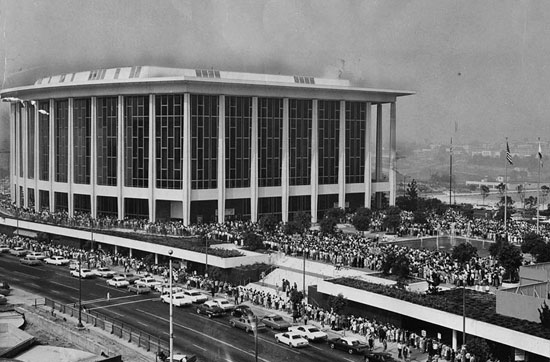
Within a year, the Music Center was a cultural fixture in L.A. Here, thousands of people line up for "Hello, Dolly" tickets. Photo/Herald Examiner
Like any grand dame, she avoids dwelling on birthdays. Still, a half-century is a milestone for a cultural icon in L.A.
So fans of the Los Angeles Music Center have gotten off to an early start in celebrating her upcoming 50-year mark. This week, a launch party on the Dorothy Chandler Pavilion stage kicked off a months-long celebration that will include some 60 large and small programs, including a gala on her December 6 golden anniversary and a public bash the next day on the Music Center Plaza.
“The Music Center has been critical to Los Angeles’ culture,” says Board Chair Lisa Specht. “We’re one of the top three performing arts centers in the country, along with Lincoln and Kennedy Centers, and for decades, we’ve been a hub of creativity.”
Not to mention a game-changer for L.A.’s metropolitan evolution.
“The Music Center was a major turning point in L.A. coming into its own in the postwar era as a major American city,” says Teresa Grimes, a Los Angeles historic preservation consultant who has documented the Center’s architectural heritage for past restoration projects.
Though the Los Angeles Philharmonic had been well established, it had no permanent home at the end of World War II other than the Hollywood Bowl, which was forced to close in 1951 due to a financial crisis, Grimes says. A series of “Save the Bowl” concerts, orchestrated by Dorothy Buffum Chandler, the wife of the Los Angeles Times’ publisher Norman Chandler, reopened the beleaguered band shell, but underscored the cultural shortcomings of the burgeoning city.
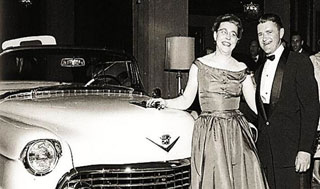
The winners of a Cadillac Eldorado, part of Dorothy Chandler's fundraising drive for Music Center construction.
Between 1951 and 1954, plans for a civic auditorium and convention center had been put on the local ballot three times, but never garnered the two-thirds majority it needed for passage. So in 1955, Chandler and the local Symphony Association began raising private funds for a hall to house the Philharmonic, which for years had been playing in leased space. As the highlight of their gala kickoff at the Ambassador Hotel, they raffled off a new Cadillac El Dorado.
“That was the beginning of it all,” Chandler is quoted as saying in Grimes’ Historic American Buildings Survey. “When we raised $400,000 in a few hours on El Dorado Night, I knew southern Californians wanted a music center badly enough to build it themselves.”
The effort took nearly a decade, at a time during which Downtown L.A. was being radically redeveloped. It required legislative approval and involved civic leaders from Donald Douglas to the Irvine family to Cecil B. De Mille.
Led by their arm-twisting society matron and her family newspaper, the Music Center boosters powered through social barriers dividing the Pasadena elite from Westside show business people, overcame pushback from provincial politicians, outlasted an economic downtown and triumphed in a last-minute squabble over whether the Center would be situated at First and Hope Streets, where the county wanted to put it, or at Chandler’s preferred location, the summit of Bunker Hill.
Chandler won, bumping the planned Department of Water and Power Building to the next block as the once-stately—and by now shabby—community of Bunker Hill was razed beyond recognition. She also brought on the architect of her choice, Welton Becket, who had worked with her on the Hollywood Bowl comeback and had master planned the campus of UCLA.
When Chandler decided during a visit to Europe that a single concert hall wouldn’t suffice, and that the new facility would do better financially if it also had a theater and a smaller forum, she won that battle also. Eventually, her tenacity in the project would put her on the cover of Time magazine.
The ultimate cost of the project was $33.5 million, with some $19 million of it from private contributions, including more than $2 million in small cash donations that local citizens dropped in so-called “Buck Bags” that were designed by Walt Disney and placed at cultural gatherings.
On December 6, 1964, the Dorothy Chandler Pavilion opened, resplendent with its crystal chandeliers and gold-leaf ceiling; the Mark Taper Forum and the Ahmanson Theatre were dedicated two years later. Opening night featured the renowned violinist Jascha Heifetz performing Beethoven’s Violin Concerto in D Major, and the Los Angeles Philharmonic conducted by a 24-year-old Zubin Mehta.
In the ensuing years, everyone who is anyone has performed at the Music Center, from Ingrid Bergman and Nat King Cole to Neil Young and Ravi Shankar. Esa-Pekka Salonen and Simon Rattle made their American debuts at the Music Center, as did groundbreaking productions from “Angels in America” to “Zoot Suit.”
Between 1969 and 1999, most of the Academy Awards ceremonies were held there. The Dorothy Chandler Pavilion is where Sacheen Littlefeather refused Marlon Brando’s Oscar, where a naked man streaked onto national television behind David Niven and where Sally Fields exalted at being really liked by the Academy.
And countless Angelenos have memories of youthful jobs as Music Center ushers.
“I worked there as an usher during my senior year of high school,” recalls William Estrada, now curator and chair of the History Department at the Natural History Museum of Los Angeles County. “It was the days of Zubin Mehta and we were required to wear these heavy, long Nehru-type jackets that were just awful to wear in the summer. Dorothy Chandler had her own parking space, and sometimes one of us was selected to walk her from her car to her seat.”
Today, Estrada notes, the Music Center, built on the site of the old Bunker Hill community, is just one cultural component in a downtown cityscape that is hardly recognizable compared to its pre-1960s, World War II incarnation. And it has expanded: The LA Phil is now housed at Disney Hall, the Center’s latest venue, and the L.A. Opera is at the Dorothy Chandler Pavilion.
Nonetheless, some things change more than others: this week’s anniversary kickoff was sponsored by Cadillac.
Click here to buy tickets to anniversary events and to share your memories of the Music Center, and here to volunteer.
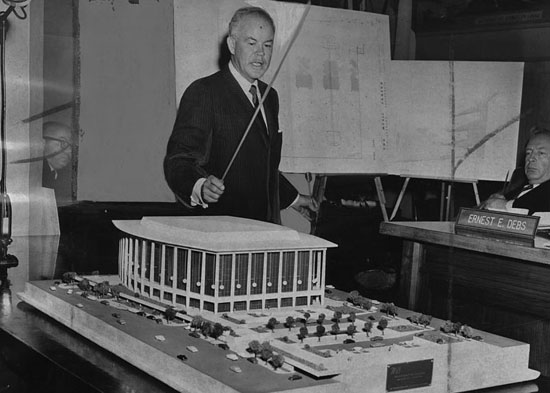
Architect Welton Becket presents plans for the new Music Center to the Board of Supervisors in 1960.
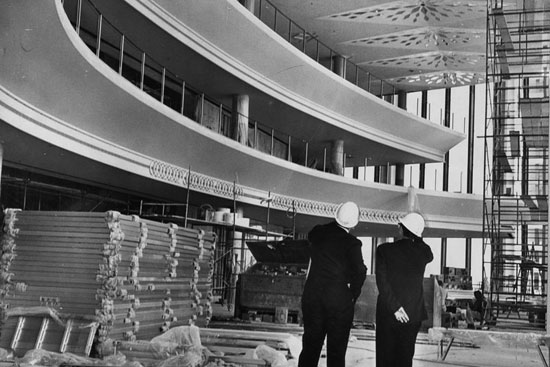
The Music Center was built as a public-nonprofit partnership on county land but was underwritten by private donations. Photo/Herald Examiner
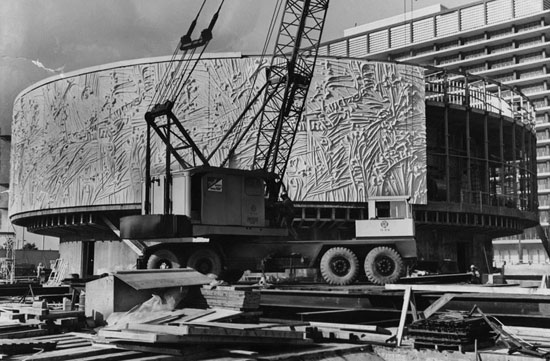
The Mark Taper Forum went up in 1966, covered with a mural of precast terrazzo. Photo/Herald Examiner
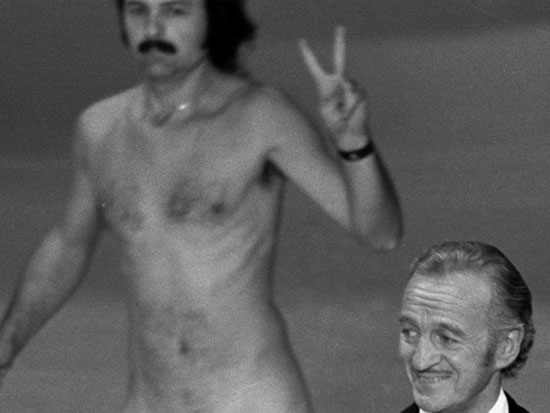
Some memorable moments occurred during the Music Center's reign as the Oscar's home. In 1974, a streaker crashed the party and actor David Niven's presentation.
Posted 4/3/14
Spreading the CicLAvia spirit
April 3, 2014

Folks from New Brunswick, New Jersey, above, to Santa Cruz are catching CicLAvia fever. Photo/Frank Villafañe & Rose Rios
Everybody wants to play in the streets these days.
And CicLAvia, a stereotype-busting open streets free-for-all that became an overnight sensation when it rolled into Los Angeles four years ago, has grabbed the handlebars of what’s becoming a nationwide movement, from small towns to big cities.
As 2014’s first CicLAvia prepares to cruise down a car-free Wilshire Boulevard Sunday, L.A. is hosting the first-ever Open Streets National Summit, drawing activists from around the country who want to see how a metropolis allegedly addicted to automobiles is using CicLAvia to reinvent itself.
Summit organizer Michael Samuelson said L.A. was chosen precisely because of the success of CicLAvia, which regularly draws crowds in excess of 100,000.
“L.A.’s got a fantastic thing going,” said Samuelson. “It’s incredibly popular; the streets are packed with people biking and walking every time.”
The Open Streets Project is working in close collaboration with the CicLAvia organization, which will give summit attendees a behind-the-scenes look at one of the most successful open streets initiatives in the nation, said Aaron Paley, executive director and co-founder of CicLAvia. Paley said that the inherent challenges in shutting down major roads in a city like L.A. are a big part of the success story.
“We are the car capital,” Paley said. “There’s this idea that if you can do it in L.A., then the sky’s the limit.”
CicLAvia started in October, 2010, as a once-per-year event inspired by mid-1970s ciclovias in Bogotá, Colombia. (“Ciclovia” translates roughly to “cycleway.”) By 2013, CicLAvia had grown to three events a year. Paley said that he expects L.A. County to get even more open streets events like CicLAvia as funding grows. “There will probably be 10 or 12 events happening around the county each year,” he said.
As CicLAvia gears up to play an even bigger role in L.A., other communities across the country are hopping aboard. As recently as 2007, only eight or nine open streets events were being held across the country, according to Samuelson. Now, they’re taking place in more than 100 cities across North America.
Some of the initiatives, like Sunday Streets in San Francisco and Summer Streets in New York City, have been serving large, bike-savvy populations for years. But the movement is also gaining traction in cities like New Brunswick, New Jersey (pop. 56,000), which held its first ciclovia last October.
“People were asking ‘Why are we doing this?’ They focused on the negative,” said Jaymie Santiago, organizer of the event and director of program operations for New Brunswick Tomorrow. “It exceeded all our expectations. We expected 2,000 people and got 4,500.”
Building on those results, New Brunswick Mayor James Cahill doubled down, partnering with the organization to produce three more ciclovias this year, starting May 4. Santiago is attending this weekend’s summit so he can bring home valuable lessons and perspective.
“Because of the scale of Los Angeles, it sets an example for smaller cities,” Santiago said. “If L.A. can do it, then New Brunswick can do it.”
At the summit, Santiago plans to share some of the early success of his event, which he said is a useful tool in his organization’s fight against poverty in New Brunswick. “One of the symptoms of poverty is isolation,” he said. “By hosting an event like this and reclaiming the streets, it kind of breaks through that.”
Jenn Graham, an organizer for Atlanta Streets Alive in Georgia, hopes the summit will provide her with ideas on how to partner with her city better. “Our event sticks out like a sore thumb because it’s one of the few that’s not organized by the city or in partnership with a city,” she said. While Atlanta Streets Alive has been able to draw some funding from the city of Atlanta, it has relied primarily on cooperation with businesses and nonprofit organizations. Still, Atlanta Streets Alive has grown rapidly, from about 1,500 people in 2010 to 83,000 last October.
Closer to home, Saskia Lucas of Santa Cruz Open Streets said she is “totally excited” to get her first taste of what she called “the largest open streets event in the United States.”
“I’ve watched videos online and it is just so inspiring to see these thousands of Angelenos just taking over major Los Angeles streets with smiles plastered on their faces.”
More of those smiles may be on tap. Last summer, Metro’s Board of Directors invested $2 million in expanding open streets events to all parts of Los Angeles County. A few months later, the board approved a grant program for local groups seeking to produce events.
The Open Streets summit starts on Friday, April 4. About 75 organizers from across the country will gather at the Line Hotel in Koreatown to share ideas, stories and advice on everything from how to grow partnerships with cities to the technical aspects of producing a safe and successful event.
Things culminate with Sunday’s CicLAvia, which will run from downtown to LACMA, in the Miracle Mile district. Locals and visitors alike will be saying so long—for now—to the six-mile long “Iconic Wilshire Boulevard” route, which is going on hiatus as construction of the Purple Line Extension prepares to get underway.
But never fear: This is Los Angeles, where another CicLAvia always seems to be right around the corner. The next one is coming on October 5 in the “Heart of L.A.” Then, on December 7, the route will focus primarily on South L.A. for the first time ever.
Posted 4/3/4







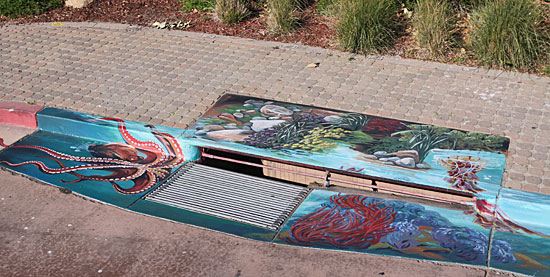

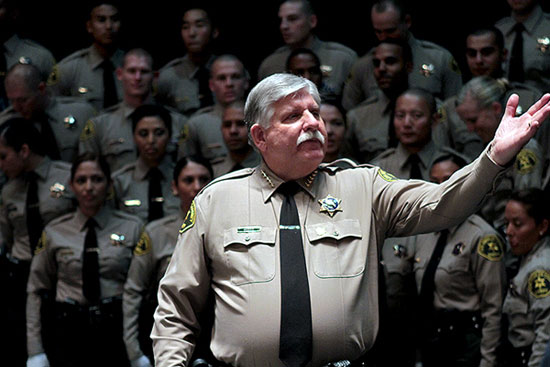
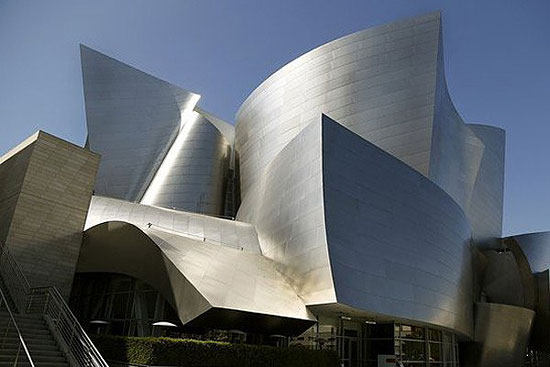
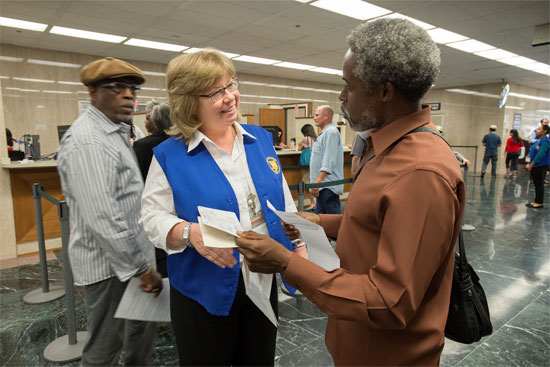

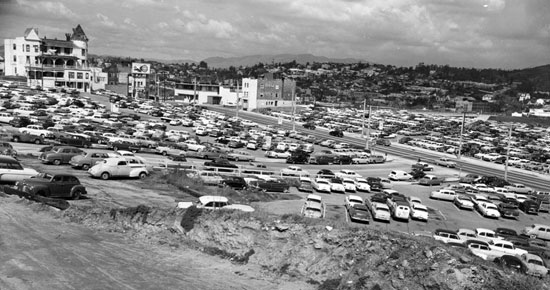
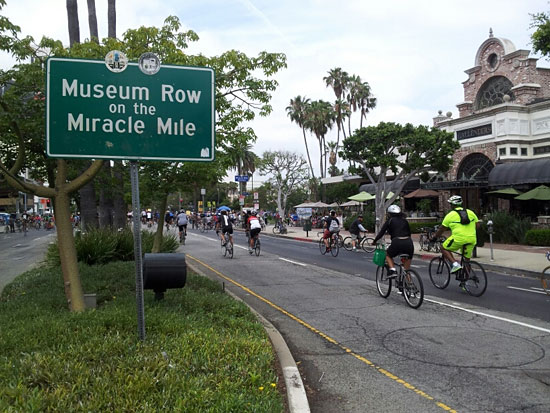





 Check for the latest closure information
Check for the latest closure information








